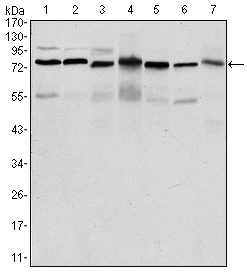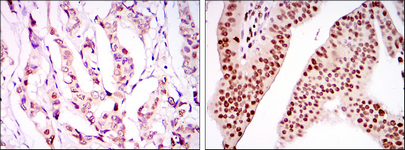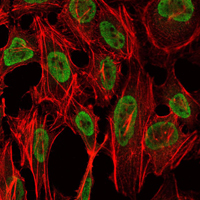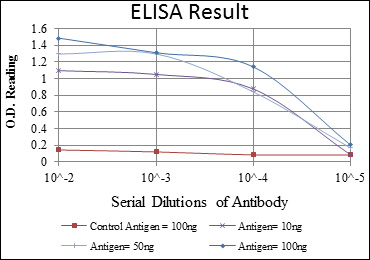LEDGF Monoclonal Antibody
- Catalog No.:YM0414
- Applications:WB;IHC;IF;ELISA
- Reactivity:Human;Rat;Monkey
- Target:
- LEDGF
- Fields:
- >>Viral life cycle - HIV-1
- Gene Name:
- PSIP1
- Protein Name:
- PC4 and SFRS1-interacting protein
- Human Gene Id:
- 11168
- Human Swiss Prot No:
- O75475
- Mouse Swiss Prot No:
- Q99JF8
- Rat Gene Id:
- 313323
- Rat Swiss Prot No:
- Q812D1
- Immunogen:
- Purified recombinant fragment of human LEDGF expressed in E. Coli.
- Specificity:
- LEDGF Monoclonal Antibody detects endogenous levels of LEDGF protein.
- Formulation:
- Liquid in PBS containing 50% glycerol, 0.5% BSA and 0.02% sodium azide.
- Source:
- Monoclonal, Mouse
- Dilution:
- WB 1:500 - 1:2000. IHC 1:200 - 1:1000. IF 1:200 - 1:1000. ELISA: 1:10000. Not yet tested in other applications.
- Purification:
- Affinity purification
- Storage Stability:
- -15°C to -25°C/1 year(Do not lower than -25°C)
- Other Name:
- PSIP1;DFS70;LEDGF;PSIP2;PC4 and SFRS1-interacting protein;CLL-associated antigen KW-7;Dense fine speckles 70 kDa protein;DFS 70;Lens epithelium-derived growth factor;Transcriptional coactivator p75/p52
- Molecular Weight(Da):
- 60kD
- References:
- 1. J Virol. 2008 Dec;82(23):11555-67.
2. Proteins. 2008 Aug;72(2):635-45.
- Background:
- disease:A chromosomal aberration involving PSIP1 is associated with pediatric acute myeloid leukemia (AML) with intermediate characteristics between M2-M3 French-American-British (FAB) subtypes. Translocation t(9;11)(p22;p15) with NUP98. The chimeric transcript is an in-frame fusion of NUP98 exon 8 to PSIP1/LEDGF exon 4.,domain:Residues 340-417 are necessary and sufficient for the interaction with HIV-1 IN (IBD domain).,function:Transcriptional coactivator involved in neuroepithelial stem cell differentiation and neurogenesis. Involved in particular in lens epithelial cell gene regulation and stress responses. May play an important role in lens epithelial to fiber cell terminal differentiation. May play a protective role during stress-induced apoptosis. Isoform 2 is a more general and stronger transcriptional coactivator. Isoform 2 may also act as an adapter to coordinate pre-mRNA splicing. Cellular cofactor for lentiviral integration.,PTM:Phosphorylated upon DNA damage, probably by ATM or ATR.,similarity:Belongs to the HDGF family.,similarity:Contains 1 PWWP domain.,subcellular location:Remains chromatin-associated throughout the cell cycle.,subunit:Monomer. Interacts with IFRD1/PC4. Isoform 2 interacts with SFRS1. Isoform 1 interacts with lentiviral integrase and acts as a chromatin tethering factor to the chromosomal DNA. Isoform 1 interacts in particular with the human HIV-1 integrase protein (HIV-1 IN), determining its nuclear localization, its tight association with chromatin and its protection from the proteasome. Isoform 1 interacts also with HIV-2 IN. Isoform 2 does not interact with HIV-1 IN.,tissue specificity:Widely expressed. Expressed at high level in the thymus. Expressed in fetal and adult brain. Expressed in neurons, but not astrocytes. Markedly elevated in fetal as compared to adult brain. In the adult brain, expressed in the subventricular zone (SVZ), in hippocampus, and undetectable elsewhere. In the fetal brain, expressed in the germinal neuroepithelium and cortical plate regions.,
- Function:
- disease:A chromosomal aberration involving PSIP1 is associated with pediatric acute myeloid leukemia (AML) with intermediate characteristics between M2-M3 French-American-British (FAB) subtypes. Translocation t(9;11)(p22;p15) with NUP98. The chimeric transcript is an in-frame fusion of NUP98 exon 8 to PSIP1/LEDGF exon 4.,domain:Residues 340-417 are necessary and sufficient for the interaction with HIV-1 IN (IBD domain).,function:Transcriptional coactivator involved in neuroepithelial stem cell differentiation and neurogenesis. Involved in particular in lens epithelial cell gene regulation and stress responses. May play an important role in lens epithelial to fiber cell terminal differentiation. May play a protective role during stress-induced apoptosis. Isoform 2 is a more general and stronger transcriptional coactivator. Isoform 2 may also act as an adapter to coordinate pre-mRNA splici
- Subcellular Location:
- Nucleus . Remains chromatin-associated throughout the cell cycle.
- Expression:
- Widely expressed. Expressed at high level in the thymus. Expressed in fetal and adult brain. Expressed in neurons, but not astrocytes. Markedly elevated in fetal as compared to adult brain. In the adult brain, expressed in the subventricular zone (SVZ), in hippocampus, and undetectable elsewhere. In the fetal brain, expressed in the germinal neuroepithelium and cortical plate regions.
- June 19-2018
- WESTERN IMMUNOBLOTTING PROTOCOL
- June 19-2018
- IMMUNOHISTOCHEMISTRY-PARAFFIN PROTOCOL
- June 19-2018
- IMMUNOFLUORESCENCE PROTOCOL
- September 08-2020
- FLOW-CYTOMEYRT-PROTOCOL
- May 20-2022
- Cell-Based ELISA│解您多样本WB检测之困扰
- July 13-2018
- CELL-BASED-ELISA-PROTOCOL-FOR-ACETYL-PROTEIN
- July 13-2018
- CELL-BASED-ELISA-PROTOCOL-FOR-PHOSPHO-PROTEIN
- July 13-2018
- Antibody-FAQs
- Products Images

- Western Blot analysis using LEDGF Monoclonal Antibody against HepG2 (1), Jurkat (2), K562 (3), Cos7 (4), PC-12 (5), HeLa (6), and NIH/3T3 (7) cell lysate.

- Immunohistochemistry analysis of paraffin-embedded breast cancer tissues (left) and ovarian cancer tissues (right) with DAB staining using LEDGF Monoclonal Antibody.

- Immunofluorescence analysis of NIH/3T3 cells using LEDGF Monoclonal Antibody (green). Red: Actin filaments have been labeled with Alexa Fluor-555 phalloidin.




